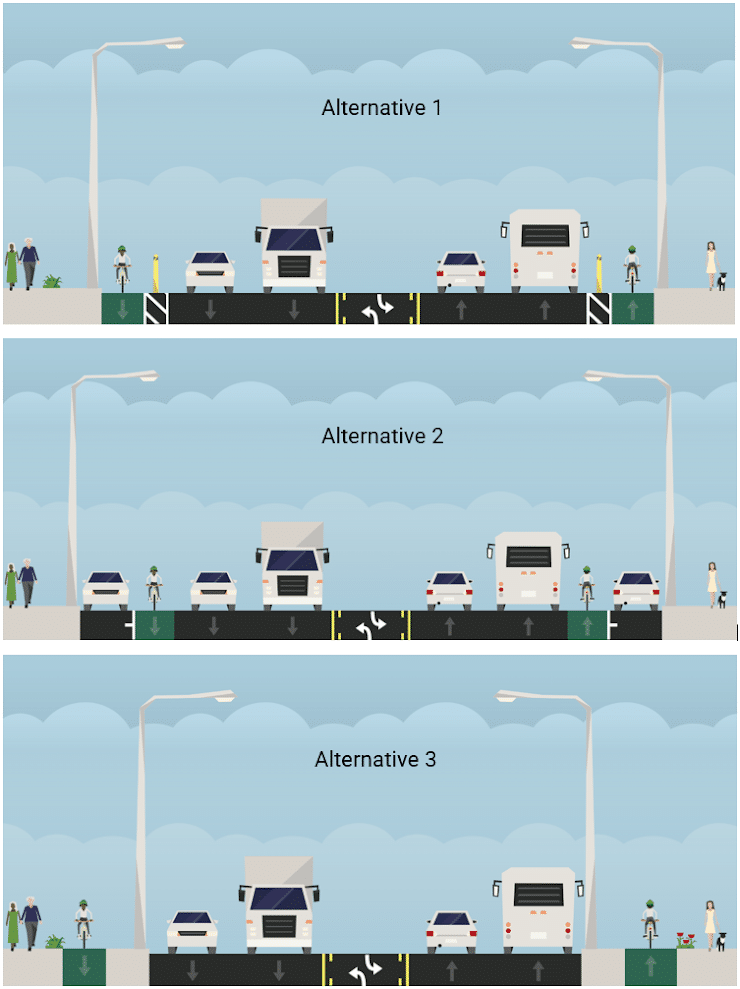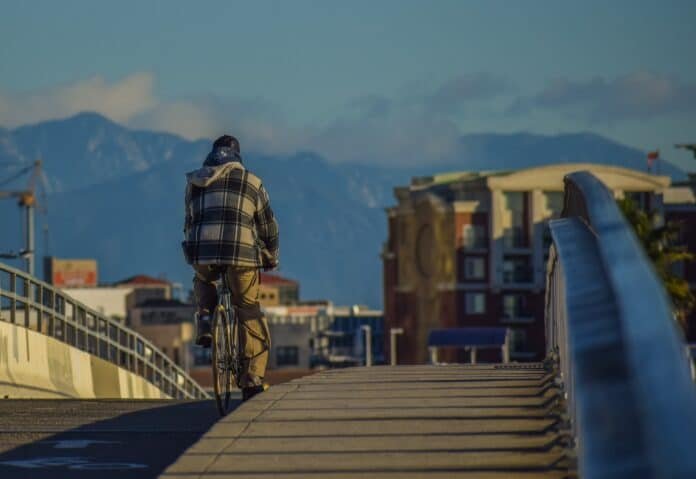Caltrans initially had Class IV bike lanes—fully protected bike lanes that separate bicyclists and motorists with hard physical barriers like curbs—planned for its rehabilitation of Pacific Coast Highway. That could very well change as the transportation agency has opted to have the community offer their say, which includes an option for Class II lanes, or bike lanes that are buffered solely by a painted line.

Wait—so why the change from having Class IV lanes to offering it up to public opinion?
On its website, Caltrans advertised that Class IV separated bike lanes would be implemented for the project. So why the survey? Will the survey determine what is built in terms of bike infrastructure?
“Yes,” said Eric Menjivar, Media Relations Manager for Caltrans District 7, via email. “Community input is an essential part of this process, and feedback received will be incorporated into the development of the project.”

There are three alternatives for this project proposal:
- Alternative 1 would convert a lane into a Class IV protected bicycle path in each direction
- Alternative 2 would accommodate a striped Class II bike lane in each direction
- Alternative 3 would remove a lane and construct a raised parkway for pedestrians and cyclists with landscape separations
So there are bike lanes going in none the matter—but the proposal that bicyclists or pedestrians would more willingly explore Pacific Coast Highway’s stretch without Alternative 1 or 3 is, to be frank, wild. And while Public Works at the City of Long Beach basically said, “We try to be as best of partners as we can with Caltrans to assure that Long Beach’s desires are met at the state-controlled level,” it is hard to not see that Long Beach had some influence in this.
Historically, Caltrans has been overwhelmingly pro-car: From letting go of employees who speak up against the archaic practice of widening freeways to lagging immensely on creating a Complete Streets guideline, Caltrans has a self-induced allergy to anything on the road but cars and trucks. And given Long Beach’s long-held Master Bicycle Plan—which included community input on roads that the City of Long Beach has no jurisdiction over, like Pacific Coast Highway—it is likely that city employees very much had an influence in getting Caltrans to include the bike and pedestrian upgrades in the first place.
Outside of the bike lanes, what are the improvements expected to be seen on Pacific Coast Highway in Long Beach?
When it comes to the rehabilitation of Pacific Coast Highway—a project that started in 2021 and spans some 18 miles of the highway from the northern Orange County line to Paseo De Las Delicias in Torrance and passing through the cities of Lomita, Long Beach, Los Angeles, and Torrance—Caltrans breaks the $600,000 project into two phases.

There is the pavement rehabilitation project which includes “pavement resurfacing, upgrade ADA curb ramps and sidewalks, enhance crosswalk visibility, install bicycle and pedestrian signage, et cetera. This project is from county line to Paseo de las Delicias in Torrance,” Menjivar said.
This part of the project will begin this winter and is expected to be completed in the winter of 2027, possibly extending into early 2028, with construction of whichever bike lane is implemented to begin in spring of 2028, with a completion in the summer in 2029.
Then there are the specific local renovations that align with the requirements of the Americans with Disabilities Act, including curb ramps, sidewalks, driveways, crosswalks, and Accessible Pedestrian Signals (APS) between the Temple Avenue and De Forest Avenue undercrossing in Long Beach. Construction on this expected to begin in spring of 2027 and will be funded by the State Highway Operation and Protection Program.



What is the point of this article?
You made me curious when I read that Caltrains is potentially reversing a plan to install fully protected bike lanes. You seem to imply a city role in this….?
The points are many: Like you said, Caltrans—instead of sticking to their original plan to install Class IV lanes—are now leaving it up to community consensus. Secondly, there is a poll to garner that community consensus; it is linked. The implication of the city’s involvement is just a quiet shout-out to them because had a role but can’t publicly comment on it.
The plans they brought to the MP&I commission were all Class II. Did you ever see drawings showing Class IV? Because none of their presentations showed them previous to this to my knowledge.
Their information page about the project literally stated Class IV lanes. And still does: https://dot.ca.gov/caltrans-near-me/district-7/district-7-projects/highway-1-improvements
Ok, so this is what they brought to Long Beach before: https://longbeach.legistar.com/View.ashx?M=F&ID=12307749&GUID=336FD51A-6C2F-4480-AD0E-E3AD89A11B71
That website is like maybe a little over a month old. They definitely weren’t planning Class IV initially.